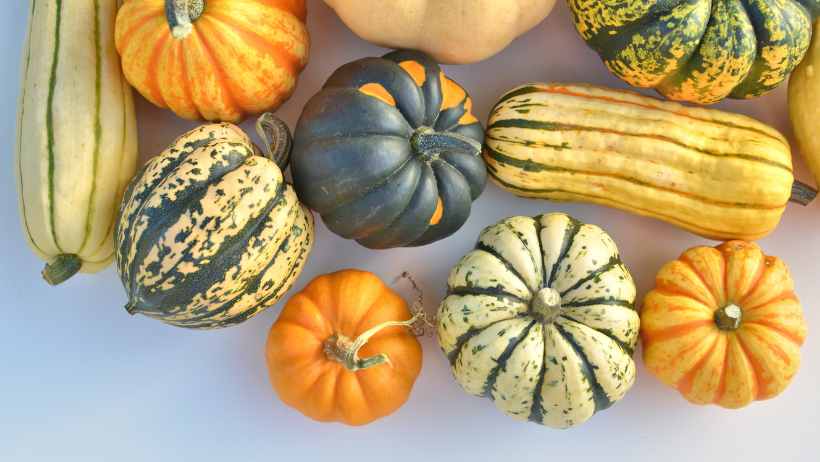
During the winter months, winter squash are a versatile and nourishing supplement to any diet. Squashes of this variety are harvested and consumed at the point of complete maturity, when they have developed a tough outer rind that renders them well-suited for extended periods of storage.
Their diversity of winter squash varieties—each with its own color, flavor, and nutritional profile—distinguishes them. As an illustration, acorn squash presents a delectable amalgamation of B vitamins, potassium, vitamin C and A, and magnesium.
Conversely, butternut squash is an excellent source of protective plant compounds, fiber, and vitamins A and C. Spaghetti squash is an excellent low-carb substitute for pasta, whereas delicata squash is renowned for its delicate skin, sweet flavor, and substantial fiber and potassium contents.
Armed with the aforementioned knowledge, one may now investigate the extensive variety of winter squash cultivars and integrate their distinct flavors and nutritional advantages into seasonal culinary preparations.
Acorn Squash Appearance and Color
The acorn squash, so named due to its unique acorn-shaped exterior, possesses a dark green epidermis. Having a smooth, rigid consistency, the rind is well-suited for extended periods of storage. The vivid yellow-orange hue of the squash’s flesh provides an attractive contrast to its verdant exterior. A compact and sleek interior tissue is present, encompassing a diminutive central cavity that harbors the seeds.
Taste
In terms of flavor, acorn squash is recognized for its delicate and subtly saccharine qualities. The hazelnut undertone of the interior of the squash becomes more pronounced during roasting or baking. Having a silky and buttery flesh enhances the overall pleasure derived from consuming this winter squash.
Nutritious Advantages
Acorn squash is an exceptionally tasty vegetable that is also rich in vital nutrients. Vitamins C and A, which are essential for a robust immune system and clear vision, are abundant in it. Moreover, acorn squash is an excellent source of B vitamins, magnesium, and potassium, all of which are essential for maintaining overall health. Additionally, acorn squash’s high fiber content stimulates healthy digestion and may aid in weight management.
Aspects of Butternut Squash Coloration
A distinctive feature of butternut squash, also known as butternut pumpkin, is its globular, elongated shape. The outer rind possesses a silky texture and is pale beige in color. The crimson hue of the squash flesh is comparable to that of the pumpkin.
A favorite flavor profile of butternut squash is its sweet and earthy aroma. The flesh is dense, silky, and buttery in texture; it retains its shape well when prepared. By roasting or cooking, butternut squash’s inherent sweetness is enhanced, rendering it an adaptable component that can be incorporated into both savory and sweet preparations.
Nutritious Advantages
This particular variety of winter squash possesses a remarkable assortment of health advantages. Fiber, which is abundant in butternut squash, promotes healthy digestion and may assist in weight maintenance. Additionally, it is rich in vitamins A and C, which support epidermis health and provide nourishment for the immune system. Furthermore, it has been demonstrated that protective plant compounds found in butternut squash, including carotenoids and antioxidants, possess anti-inflammatory and disease-preventing properties.
Spaghetti Squash Visual Appeal and Color
Spaghetti squash is so-called due to the distinctive consistency of its roasted interior, which resembles spaghetti filaments. Spaghetti squash has a delicate yellow or golden exterior rind. It is silky in texture and varies in form and dimension.
Due to its moderate and neutral flavor, spaghetti squash readily absorbs the characteristics of other ingredients with which it is prepared. Similar in texture to al dente pasta, the stewed interior of spaghetti squash is slightly crunchy, making it a popular low-carb substitute for traditional noodles.
Nutritious Advantages
Spaghetti squash is widely esteemed for its calorie and low-carb composition. Individuals who are on a strict diet or endeavor to decrease their carbohydrate consumption should consider utilizing this product. Spaghetti squash is excellent in vitamins and minerals, including folate, manganese, and vitamin C, despite its minimal carbohydrate content. Antioxidants, which aid in protecting the body against oxidative stress and inflammation, are also present.
Delicata Squash Appearance and Color
Sweet potato squash, also referred to as delicata squash, is relatively diminutive in size when contrasted with other varieties of winter squash. It possesses a cylindrical morphology and is coated in cream-colored, orange or green patterns. As its name suggests, delicata squash has a thin, delicate exterior.
The sweet and buttery flavor of Taste Delicata squash is frequently compared to that of sweet potatoes. The tissue is supple and silky, which facilitates enjoyment. The edible nature of the delicata squash’s thin skin enhances the overall culinary and consuming experience in terms of both convenience and flavor.
Nutritious Advantages
Although delicata squash is relatively diminutive in size, it carries a significant nutritional wallop. It aids in weight management and promotes healthy digestion due to its high dietary fiber content. Additionally, delicata squash is rich in potassium, an indispensable mineral that aids in the maintenance of healthy muscles and the cardiovascular system. In addition, delicata squash’s elevated fiber content may promote satiety and a sense of fullness, thereby facilitating the maintenance of healthy eating patterns.
Red Kuri Squash Appearance and Color
The outer exterior of red kuri squash, which is also referred to as Hokkaido squash, is a shade of reddish-orange. The texture of the rind is faintly rough but otherwise silky. Although crimson kuri squash can have any shape, it is typically round or teardrop-shaped.
Taste
It is well-known that red kuri squash has a naturally delicious flavor. When cooked, the flesh’s velvety, buttery consistency becomes even more tender. Red kuri squash is an adaptable ingredient in both sweet and savory dishes due to its fragrant flavor.
Nutritious Advantages
In addition to its gustatory appeal, red kuri squash provides an abundance of health benefits. Its high vitamin A and C content supports eye health and provides an immune system boost. Red kuri squash seeds are an excellent source of minerals including iron and magnesium, as well as protein and healthful lipids. The nutritional composition of red kuri squash is enhanced through the provision of dietary fiber, which is edible.
Coloring and Presentation of Sweet Dumpling Squash
The sweet dumpling squash is a distinctively shaped, tiny winter squash. Squat and round in shape, it resembles a miniature pumpkin. Sweet dumpling squash has a pale yellow exterior rind with dark green patches or patterns. The rind possesses a robust, silky consistency.
Taste
Sweet dumpling squash, as its name implies, possesses an intrinsically sweet taste. The flesh possesses a succulent, buttery consistency and a melt-in-the-mouth quality. The velvety and silky consistency of sweet dumpling squash enhances its palatability as a culinary component.
Nutritious Advantages
Sweet dumpling squash is an aesthetically pleasing and nutritionally dense complement to dishes. It supports healthy digestion and is relatively low in calories and high in dietary fiber, making it an excellent option for those attempting to control their caloric intake. Antioxidants, which are abundant in sweet dumpling squash, safeguard the body against free radical damage. Antioxidants have the potential to enhance general health and potentially mitigate the development of chronic ailments.
Musquée tradiţionale
Color and Visual Appeal
The appearance of Musquée de Provence, also referred to as Provence pumpkin, a French winter gourd, elevates it to a high status. Its corrugated, flattened form is complemented by a vivid orange rind. The dense, robust texture of the rind makes it an excellent material for long-term storage.
Cooking enhances the sweet and earthy flavor of Taste Musquée de Provence. The flesh is velvety and silky, creating the delightful sensation of it melting in your mouth. Due to its delectable flavor and consistency, Musquée de Provence is an adaptable ingredient in a wide range of culinary preparations.
Nutritious Advantages
Musquée de Provence, apart from its delectable flavor, provides an extensive array of nutritional advantages. It is abundant in vitamins A and C, both of which contribute to excellent vision and a healthy immune system. The flesh’s vivid orange hue signifies the existence of beta-carotene, a potent antioxidant that aids in cellular protection against harm. Musquée de Provence is also an excellent source of fiber and essential minerals for optimal health, including magnesium and potassium.
Aspects of North Georgia Candy Roaster Squash Pupils
North Georgia Candy Roaster is a variety of winter squash that can attain remarkable growth rates. The texture of the outer rind is coarse and it ranges in color from tan to greenish-gray. North Georgia Candy Roaster squash has an irregular shape, characterized by a bulbous apex and a tapering neck.
Taste
It is well-known that the sweetness and nuttiness of this variety of squash intensify with cooking. The flesh possesses an appealing texture due to its density and smoothness. North Georgia Candy Roaster squash is frequently utilized in pies, stews, and other delectable preparations due to its inherent sweetness.
Nutritious Advantages
Squash from North Georgia Candy Roaster is not only delectable but also provides essential nutritional benefits. It is rich in vitamins A and C, which promote healthy epidermis and immune function. North Georgia Candy Roaster squash is rich in fiber, which assists digestion and contributes to weight maintenance, due to its large size. Additionally, this variety of winter squash contains minerals like magnesium and potassium, which are essential for healthy muscle and cardiovascular function.
Kabocha Squash Appearance and Color
The Japanese pumpkin, or Kabocha squash, possesses a visually arresting appearance. The outer rind is robust and rough, with a dark green hue. While kabocha squashes can have any shape, they are typically round and compact.
Kabocha squash is widely recognized for its delectable sweetness and silky consistency. The flesh is velvety and substantial, providing a texture that is both rich and creamy. As a result of the intensification of its inherent sweetness during cooking, kabocha squash is a widely used ingredient in a variety of dishes.
Nutritious Advantages
Kabocha squash is not only a delectable fruit but also a rich source of vital nutrients. It aids in weight management and promotes healthy digestion due to its high fiber content. Additionally, kabocha squash is an excellent source of vitamins A and C, which support healthy epidermis and bolster the immune system. Furthermore, it is composed of vital minerals, including magnesium and potassium, that are intrinsic to the proper functioning of the body.
Blue Hubbard Squash Appearance and Color
As its name implies, the rind of Blue Hubbard squash is a distinct shade of bluish-green. The dense, undulating exterior epidermis imparts a rugged appearance. Blue Hubbard squash has a substantial, elongated form, characterized by a marginally compressed lower portion.
Cooking enhances the mildly sweet flavor of Taste Blue Hubbard squash. The succulent and substantial flesh offers a gratifying gustatory encounter. Blue Hubbard squash possesses a robust and silky texture, rendering it amenable to a wide range of culinary techniques.
Nutritious Advantages
Notwithstanding its robust exterior, Blue Hubbard squash provides significant nutritional advantages. It can contribute to weight management and promote a healthy digestive system due to its high dietary fiber content. Additionally, blue hubbard squash is an excellent source of vitamins A and C, which are vital for maintaining a healthy epidermis and robust immune system. Moreover, it is rich in minerals such as magnesium and potassium, which are essential for the maintenance of optimal health.
In summary, winter squash cultivars exhibit a diverse array of pigments, aesthetics, gustatory profiles, and nutritional advantages. Acorn squash, which is mild and subtly sweet, and kabocha squash, which is sweet and buttery, are all squash varieties that possess distinctive qualities and tastes. It is imperative to acknowledge the significant nutritional value of winter squash, given its provision of vital vitamins, minerals, and fiber. Winter squash, whether filled, broiled, or roasted, can be a scrumptious and nourishing addition to any dish.










